NURSING ASSIGNMENT.
VerifiedAdded on 2023/04/11
|10
|1865
|96
AI Summary
Contribute Materials
Your contribution can guide someone’s learning journey. Share your
documents today.
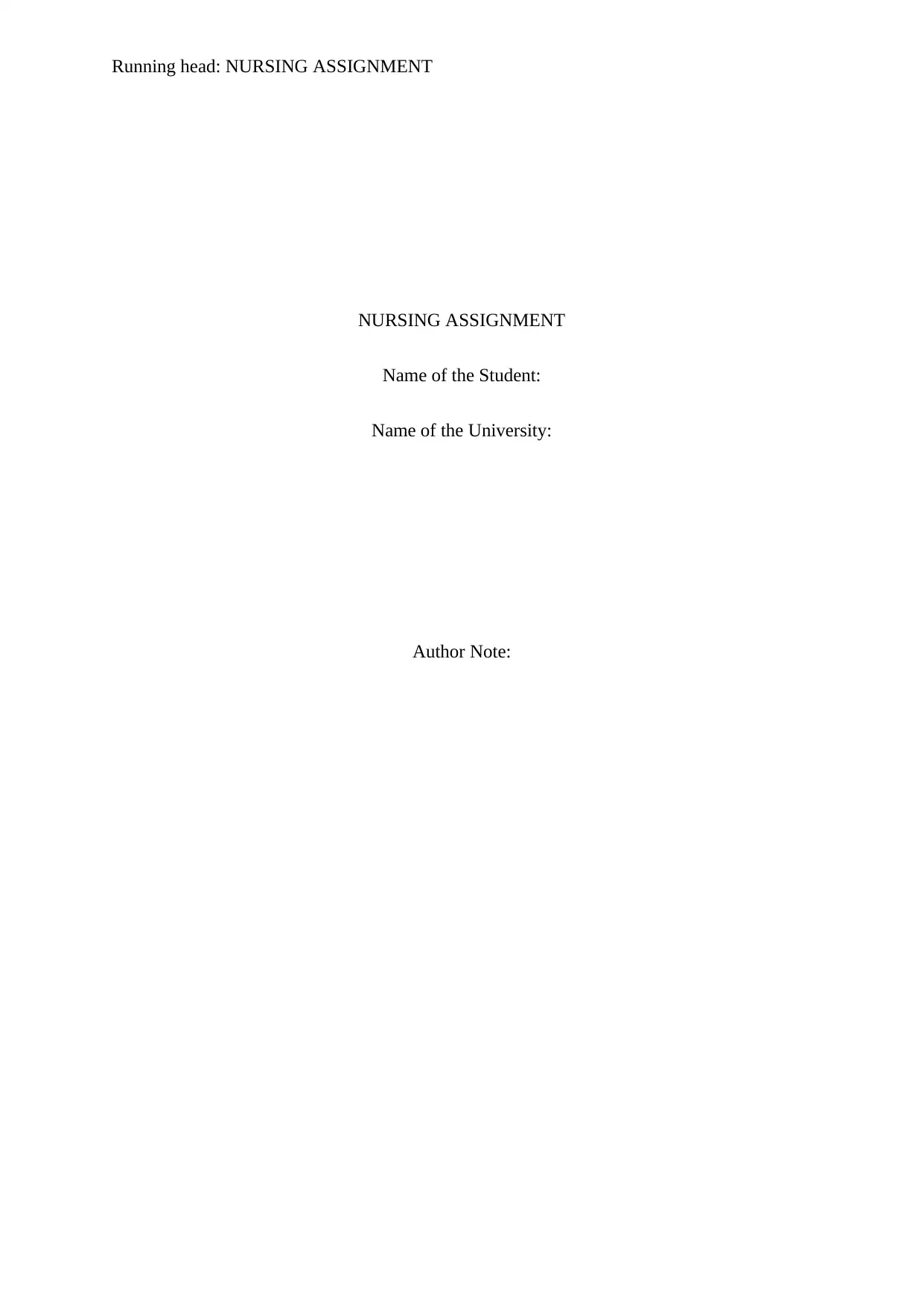
Running head: NURSING ASSIGNMENT
NURSING ASSIGNMENT
Name of the Student:
Name of the University:
Author Note:
NURSING ASSIGNMENT
Name of the Student:
Name of the University:
Author Note:
Secure Best Marks with AI Grader
Need help grading? Try our AI Grader for instant feedback on your assignments.
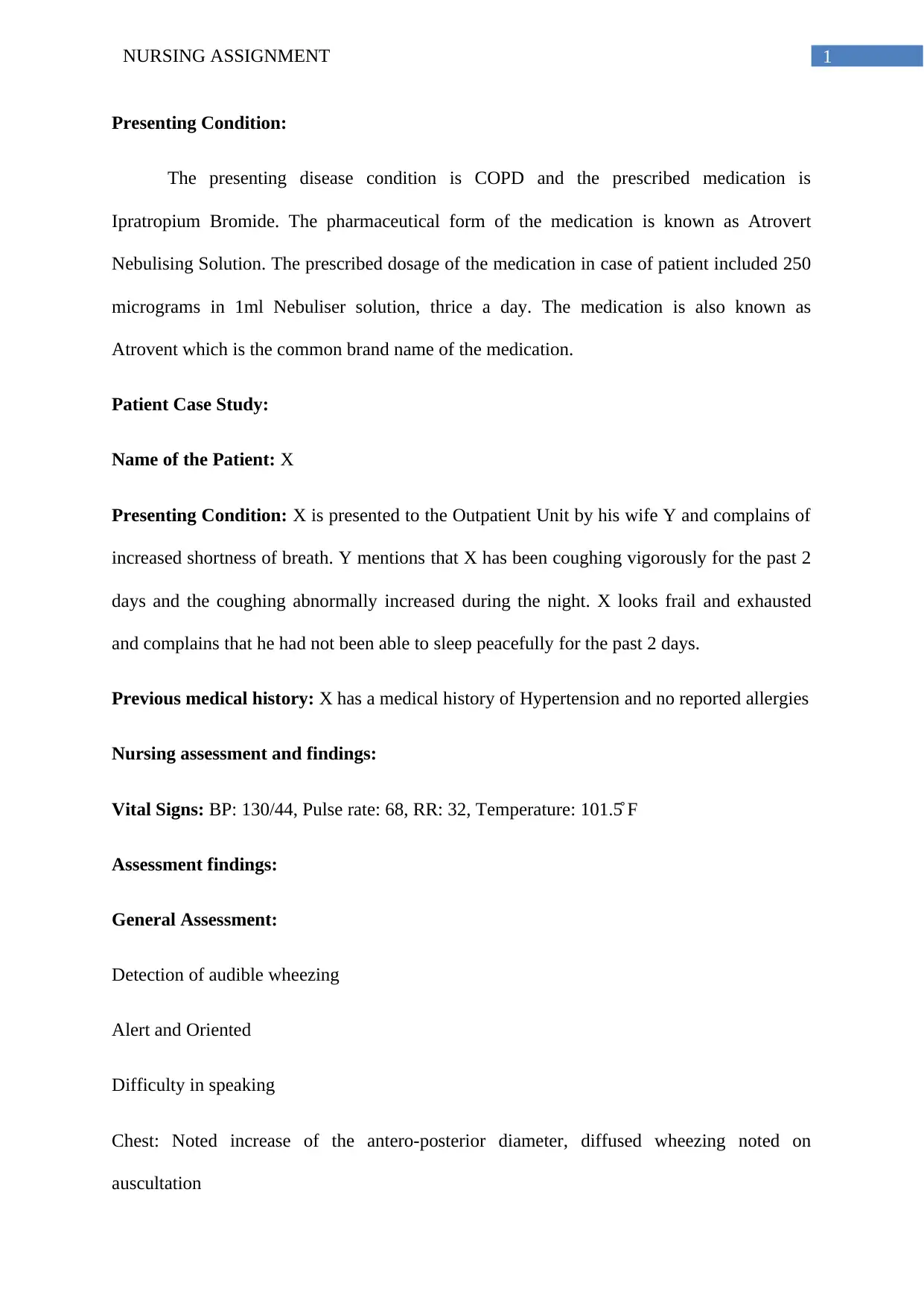
1NURSING ASSIGNMENT
Presenting Condition:
The presenting disease condition is COPD and the prescribed medication is
Ipratropium Bromide. The pharmaceutical form of the medication is known as Atrovert
Nebulising Solution. The prescribed dosage of the medication in case of patient included 250
micrograms in 1ml Nebuliser solution, thrice a day. The medication is also known as
Atrovent which is the common brand name of the medication.
Patient Case Study:
Name of the Patient: X
Presenting Condition: X is presented to the Outpatient Unit by his wife Y and complains of
increased shortness of breath. Y mentions that X has been coughing vigorously for the past 2
days and the coughing abnormally increased during the night. X looks frail and exhausted
and complains that he had not been able to sleep peacefully for the past 2 days.
Previous medical history: X has a medical history of Hypertension and no reported allergies
Nursing assessment and findings:
Vital Signs: BP: 130/44, Pulse rate: 68, RR: 32, Temperature: 101.5̊ F
Assessment findings:
General Assessment:
Detection of audible wheezing
Alert and Oriented
Difficulty in speaking
Chest: Noted increase of the antero-posterior diameter, diffused wheezing noted on
auscultation
Presenting Condition:
The presenting disease condition is COPD and the prescribed medication is
Ipratropium Bromide. The pharmaceutical form of the medication is known as Atrovert
Nebulising Solution. The prescribed dosage of the medication in case of patient included 250
micrograms in 1ml Nebuliser solution, thrice a day. The medication is also known as
Atrovent which is the common brand name of the medication.
Patient Case Study:
Name of the Patient: X
Presenting Condition: X is presented to the Outpatient Unit by his wife Y and complains of
increased shortness of breath. Y mentions that X has been coughing vigorously for the past 2
days and the coughing abnormally increased during the night. X looks frail and exhausted
and complains that he had not been able to sleep peacefully for the past 2 days.
Previous medical history: X has a medical history of Hypertension and no reported allergies
Nursing assessment and findings:
Vital Signs: BP: 130/44, Pulse rate: 68, RR: 32, Temperature: 101.5̊ F
Assessment findings:
General Assessment:
Detection of audible wheezing
Alert and Oriented
Difficulty in speaking
Chest: Noted increase of the antero-posterior diameter, diffused wheezing noted on
auscultation
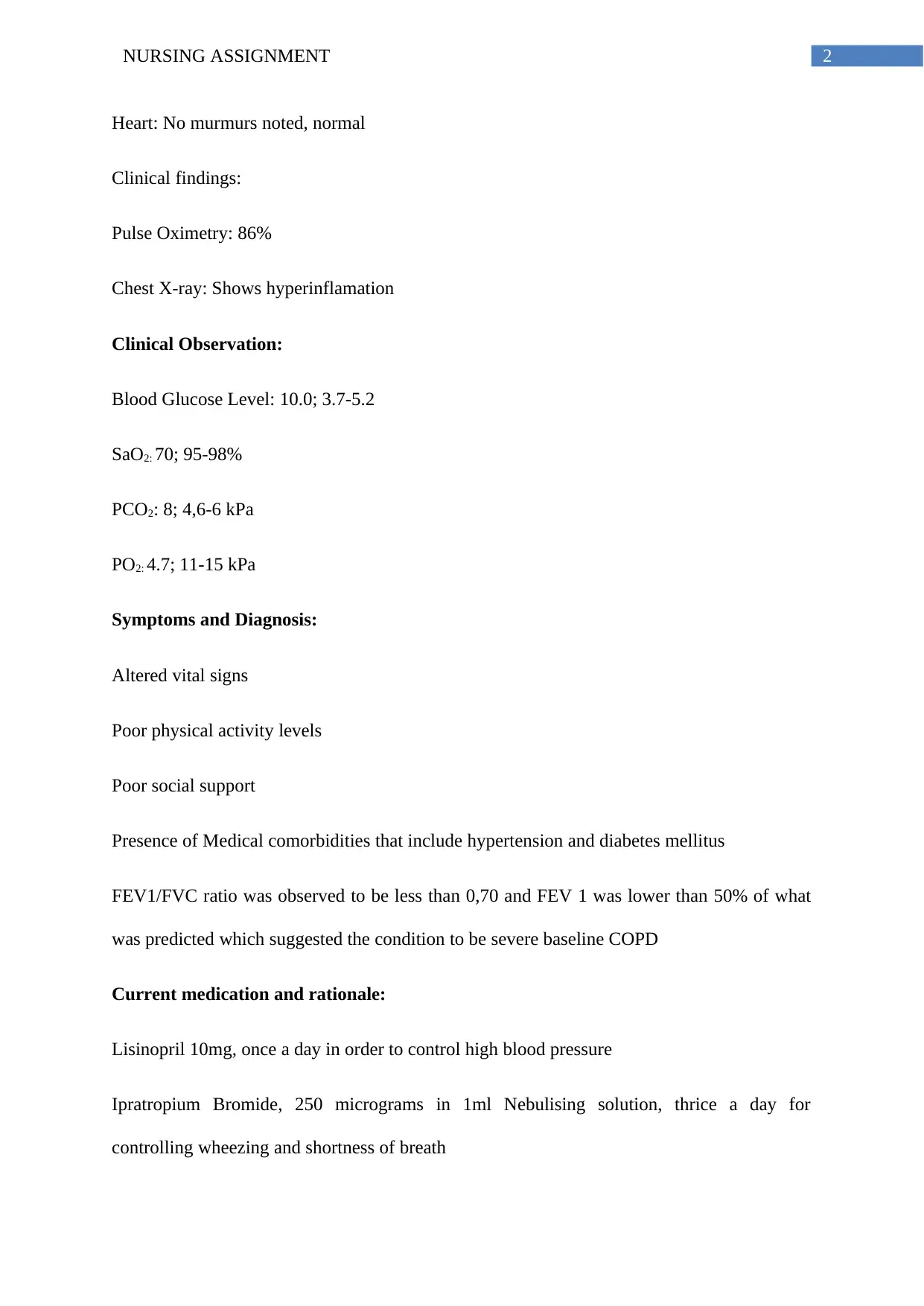
2NURSING ASSIGNMENT
Heart: No murmurs noted, normal
Clinical findings:
Pulse Oximetry: 86%
Chest X-ray: Shows hyperinflamation
Clinical Observation:
Blood Glucose Level: 10.0; 3.7-5.2
SaO2: 70; 95-98%
PCO2: 8; 4,6-6 kPa
PO2: 4.7; 11-15 kPa
Symptoms and Diagnosis:
Altered vital signs
Poor physical activity levels
Poor social support
Presence of Medical comorbidities that include hypertension and diabetes mellitus
FEV1/FVC ratio was observed to be less than 0,70 and FEV 1 was lower than 50% of what
was predicted which suggested the condition to be severe baseline COPD
Current medication and rationale:
Lisinopril 10mg, once a day in order to control high blood pressure
Ipratropium Bromide, 250 micrograms in 1ml Nebulising solution, thrice a day for
controlling wheezing and shortness of breath
Heart: No murmurs noted, normal
Clinical findings:
Pulse Oximetry: 86%
Chest X-ray: Shows hyperinflamation
Clinical Observation:
Blood Glucose Level: 10.0; 3.7-5.2
SaO2: 70; 95-98%
PCO2: 8; 4,6-6 kPa
PO2: 4.7; 11-15 kPa
Symptoms and Diagnosis:
Altered vital signs
Poor physical activity levels
Poor social support
Presence of Medical comorbidities that include hypertension and diabetes mellitus
FEV1/FVC ratio was observed to be less than 0,70 and FEV 1 was lower than 50% of what
was predicted which suggested the condition to be severe baseline COPD
Current medication and rationale:
Lisinopril 10mg, once a day in order to control high blood pressure
Ipratropium Bromide, 250 micrograms in 1ml Nebulising solution, thrice a day for
controlling wheezing and shortness of breath
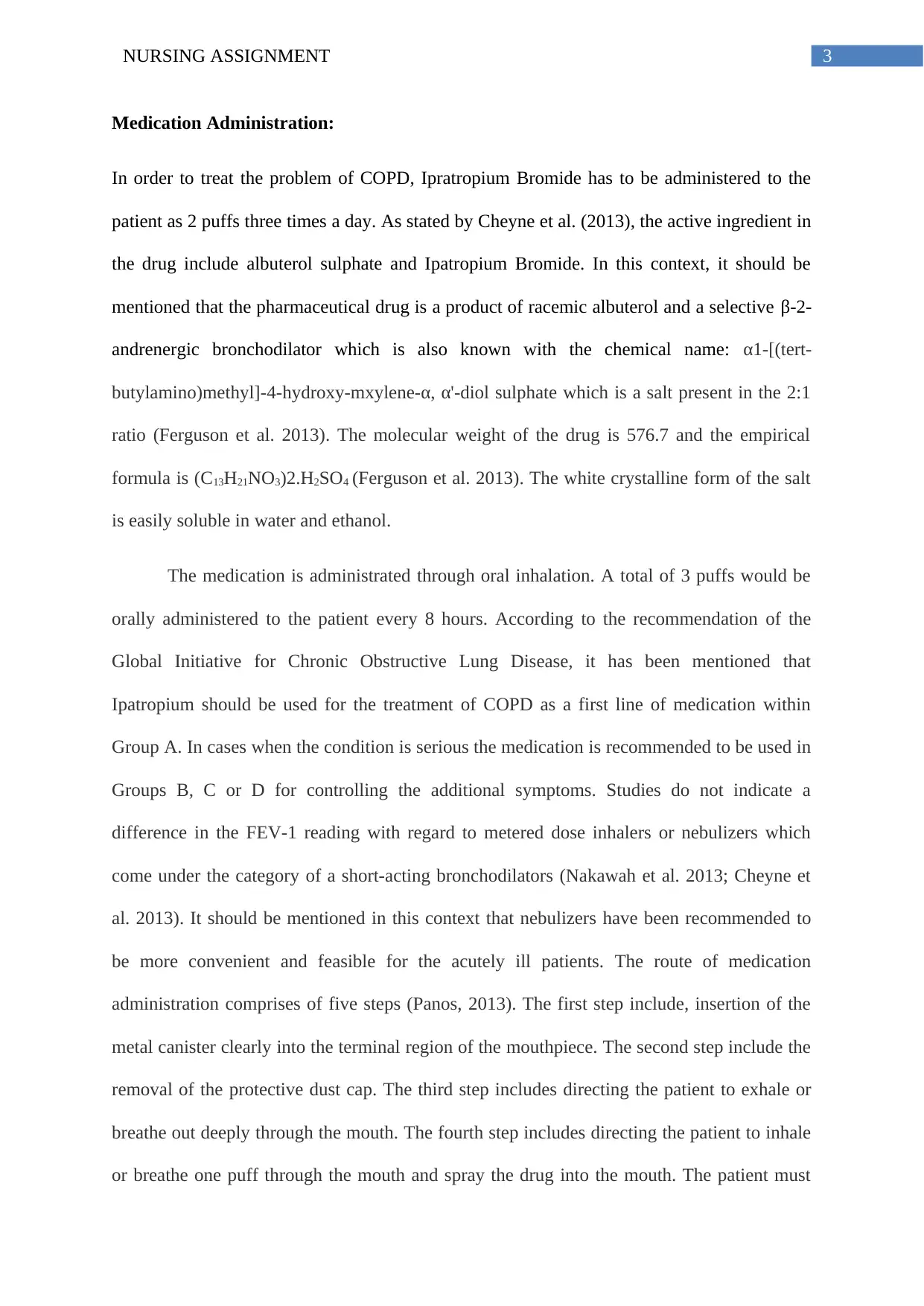
3NURSING ASSIGNMENT
Medication Administration:
In order to treat the problem of COPD, Ipratropium Bromide has to be administered to the
patient as 2 puffs three times a day. As stated by Cheyne et al. (2013), the active ingredient in
the drug include albuterol sulphate and Ipatropium Bromide. In this context, it should be
mentioned that the pharmaceutical drug is a product of racemic albuterol and a selective β-2-
andrenergic bronchodilator which is also known with the chemical name: α1-[(tert-
butylamino)methyl]-4-hydroxy-mxylene-α, α'-diol sulphate which is a salt present in the 2:1
ratio (Ferguson et al. 2013). The molecular weight of the drug is 576.7 and the empirical
formula is (C13H21NO3)2.H2SO4 (Ferguson et al. 2013). The white crystalline form of the salt
is easily soluble in water and ethanol.
The medication is administrated through oral inhalation. A total of 3 puffs would be
orally administered to the patient every 8 hours. According to the recommendation of the
Global Initiative for Chronic Obstructive Lung Disease, it has been mentioned that
Ipatropium should be used for the treatment of COPD as a first line of medication within
Group A. In cases when the condition is serious the medication is recommended to be used in
Groups B, C or D for controlling the additional symptoms. Studies do not indicate a
difference in the FEV-1 reading with regard to metered dose inhalers or nebulizers which
come under the category of a short-acting bronchodilators (Nakawah et al. 2013; Cheyne et
al. 2013). It should be mentioned in this context that nebulizers have been recommended to
be more convenient and feasible for the acutely ill patients. The route of medication
administration comprises of five steps (Panos, 2013). The first step include, insertion of the
metal canister clearly into the terminal region of the mouthpiece. The second step include the
removal of the protective dust cap. The third step includes directing the patient to exhale or
breathe out deeply through the mouth. The fourth step includes directing the patient to inhale
or breathe one puff through the mouth and spray the drug into the mouth. The patient must
Medication Administration:
In order to treat the problem of COPD, Ipratropium Bromide has to be administered to the
patient as 2 puffs three times a day. As stated by Cheyne et al. (2013), the active ingredient in
the drug include albuterol sulphate and Ipatropium Bromide. In this context, it should be
mentioned that the pharmaceutical drug is a product of racemic albuterol and a selective β-2-
andrenergic bronchodilator which is also known with the chemical name: α1-[(tert-
butylamino)methyl]-4-hydroxy-mxylene-α, α'-diol sulphate which is a salt present in the 2:1
ratio (Ferguson et al. 2013). The molecular weight of the drug is 576.7 and the empirical
formula is (C13H21NO3)2.H2SO4 (Ferguson et al. 2013). The white crystalline form of the salt
is easily soluble in water and ethanol.
The medication is administrated through oral inhalation. A total of 3 puffs would be
orally administered to the patient every 8 hours. According to the recommendation of the
Global Initiative for Chronic Obstructive Lung Disease, it has been mentioned that
Ipatropium should be used for the treatment of COPD as a first line of medication within
Group A. In cases when the condition is serious the medication is recommended to be used in
Groups B, C or D for controlling the additional symptoms. Studies do not indicate a
difference in the FEV-1 reading with regard to metered dose inhalers or nebulizers which
come under the category of a short-acting bronchodilators (Nakawah et al. 2013; Cheyne et
al. 2013). It should be mentioned in this context that nebulizers have been recommended to
be more convenient and feasible for the acutely ill patients. The route of medication
administration comprises of five steps (Panos, 2013). The first step include, insertion of the
metal canister clearly into the terminal region of the mouthpiece. The second step include the
removal of the protective dust cap. The third step includes directing the patient to exhale or
breathe out deeply through the mouth. The fourth step includes directing the patient to inhale
or breathe one puff through the mouth and spray the drug into the mouth. The patient must
Secure Best Marks with AI Grader
Need help grading? Try our AI Grader for instant feedback on your assignments.

4NURSING ASSIGNMENT
breathe deeply during this time and the final step requires the patient to hold the breath for a
period of 10 seconds and then withdraw the mouth piece and exhale slowly. Ideally the
routine suggests that the patient must pause for a period of 15 seconds and then repeat the
third, fourth and fifth steps for the second puff.
The rationale for the oral administration of the drug includes the spontaneous
availability to the congested region within the lungs and helps in relaxing the obstructed
airway (Montuschi et al. 2013). Studies indicate that the medication acts as a competitive
antagonist against the muscarinic acetylcholine receptors. The drug has been reported to
possess a high affinity for the bronchial receptors when inhaled or administered intravenously
(Tashkin and Ferguson 2013). Also, the drug does not lead to tachycardia and no
anticholinergic effect have been reported that could potentially interfere with the cardiac
function, bladder function or the eye (Sharafkhaneh et al. 2013). The inhalation of 0.04mg of
the drug in the form of aerosol has been observed to cause bronchodilation within a span of
30 minutes and the effect lasts for up to 4-6 hours (Sharafkhaneh et al. 2013). However, it is
important to note here that using a combination of the drug with a nebulise has been reported
to produce maximum bronchodilation.
Ipratropium bromide is strongly recommended for the treatment of reversible
bronchospasm that is associated with COPD. The medication is used as an inhalation product
and the dose for adults might vary between 250-500 grams with 1 ml or 2 ml Nebulizer
(Ejiofor and Turner 2013).
A set of safety considerations should be considered while administering the drug. The
nebuliser solution must be used under close medical supervision. Studies suggest that a
critical consideration of the associated comorbidities of the patient must be taken into
consideration prior to the medication administration so as to avoid adverse side-effects. This
breathe deeply during this time and the final step requires the patient to hold the breath for a
period of 10 seconds and then withdraw the mouth piece and exhale slowly. Ideally the
routine suggests that the patient must pause for a period of 15 seconds and then repeat the
third, fourth and fifth steps for the second puff.
The rationale for the oral administration of the drug includes the spontaneous
availability to the congested region within the lungs and helps in relaxing the obstructed
airway (Montuschi et al. 2013). Studies indicate that the medication acts as a competitive
antagonist against the muscarinic acetylcholine receptors. The drug has been reported to
possess a high affinity for the bronchial receptors when inhaled or administered intravenously
(Tashkin and Ferguson 2013). Also, the drug does not lead to tachycardia and no
anticholinergic effect have been reported that could potentially interfere with the cardiac
function, bladder function or the eye (Sharafkhaneh et al. 2013). The inhalation of 0.04mg of
the drug in the form of aerosol has been observed to cause bronchodilation within a span of
30 minutes and the effect lasts for up to 4-6 hours (Sharafkhaneh et al. 2013). However, it is
important to note here that using a combination of the drug with a nebulise has been reported
to produce maximum bronchodilation.
Ipratropium bromide is strongly recommended for the treatment of reversible
bronchospasm that is associated with COPD. The medication is used as an inhalation product
and the dose for adults might vary between 250-500 grams with 1 ml or 2 ml Nebulizer
(Ejiofor and Turner 2013).
A set of safety considerations should be considered while administering the drug. The
nebuliser solution must be used under close medical supervision. Studies suggest that a
critical consideration of the associated comorbidities of the patient must be taken into
consideration prior to the medication administration so as to avoid adverse side-effects. This
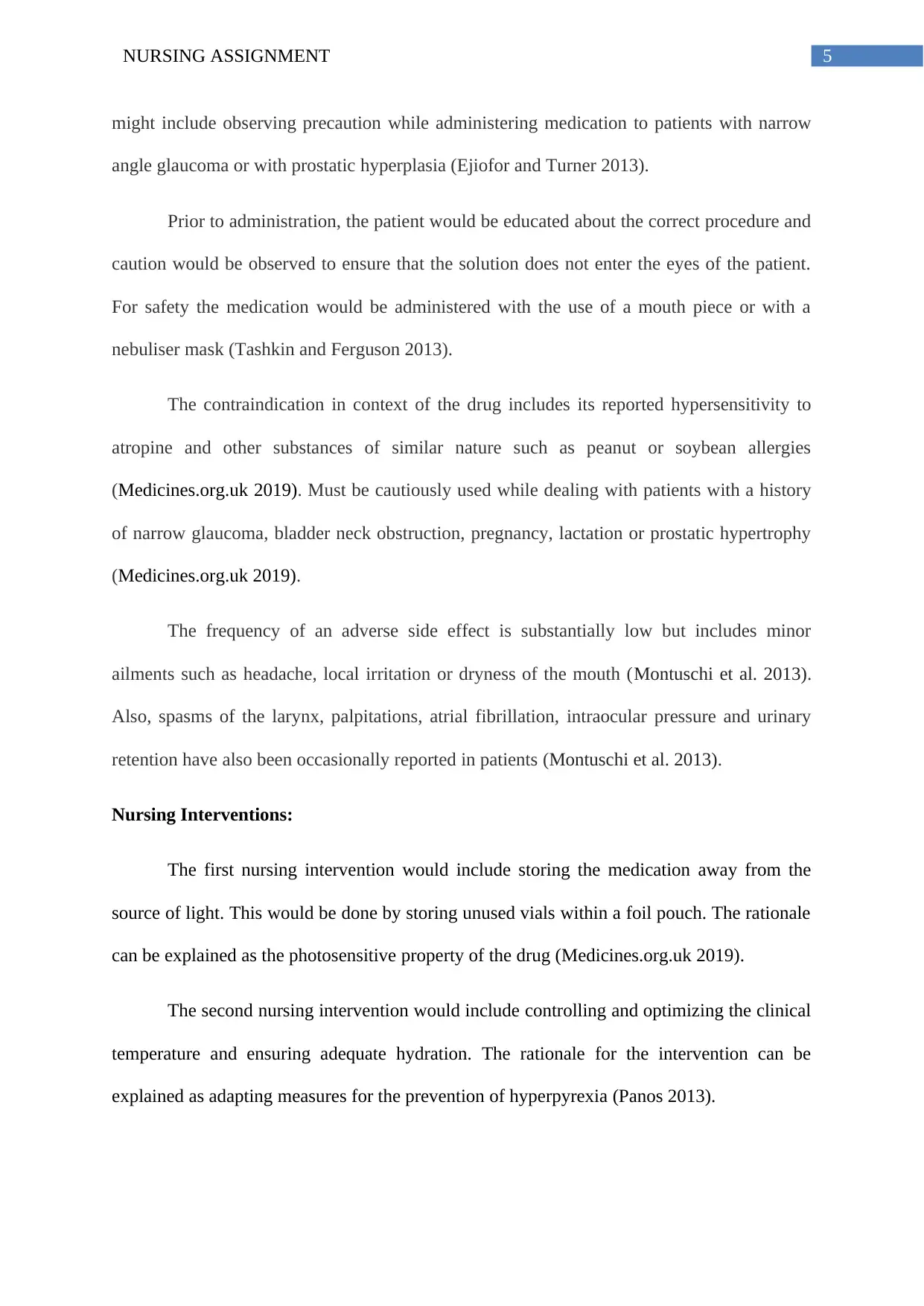
5NURSING ASSIGNMENT
might include observing precaution while administering medication to patients with narrow
angle glaucoma or with prostatic hyperplasia (Ejiofor and Turner 2013).
Prior to administration, the patient would be educated about the correct procedure and
caution would be observed to ensure that the solution does not enter the eyes of the patient.
For safety the medication would be administered with the use of a mouth piece or with a
nebuliser mask (Tashkin and Ferguson 2013).
The contraindication in context of the drug includes its reported hypersensitivity to
atropine and other substances of similar nature such as peanut or soybean allergies
(Medicines.org.uk 2019). Must be cautiously used while dealing with patients with a history
of narrow glaucoma, bladder neck obstruction, pregnancy, lactation or prostatic hypertrophy
(Medicines.org.uk 2019).
The frequency of an adverse side effect is substantially low but includes minor
ailments such as headache, local irritation or dryness of the mouth (Montuschi et al. 2013).
Also, spasms of the larynx, palpitations, atrial fibrillation, intraocular pressure and urinary
retention have also been occasionally reported in patients (Montuschi et al. 2013).
Nursing Interventions:
The first nursing intervention would include storing the medication away from the
source of light. This would be done by storing unused vials within a foil pouch. The rationale
can be explained as the photosensitive property of the drug (Medicines.org.uk 2019).
The second nursing intervention would include controlling and optimizing the clinical
temperature and ensuring adequate hydration. The rationale for the intervention can be
explained as adapting measures for the prevention of hyperpyrexia (Panos 2013).
might include observing precaution while administering medication to patients with narrow
angle glaucoma or with prostatic hyperplasia (Ejiofor and Turner 2013).
Prior to administration, the patient would be educated about the correct procedure and
caution would be observed to ensure that the solution does not enter the eyes of the patient.
For safety the medication would be administered with the use of a mouth piece or with a
nebuliser mask (Tashkin and Ferguson 2013).
The contraindication in context of the drug includes its reported hypersensitivity to
atropine and other substances of similar nature such as peanut or soybean allergies
(Medicines.org.uk 2019). Must be cautiously used while dealing with patients with a history
of narrow glaucoma, bladder neck obstruction, pregnancy, lactation or prostatic hypertrophy
(Medicines.org.uk 2019).
The frequency of an adverse side effect is substantially low but includes minor
ailments such as headache, local irritation or dryness of the mouth (Montuschi et al. 2013).
Also, spasms of the larynx, palpitations, atrial fibrillation, intraocular pressure and urinary
retention have also been occasionally reported in patients (Montuschi et al. 2013).
Nursing Interventions:
The first nursing intervention would include storing the medication away from the
source of light. This would be done by storing unused vials within a foil pouch. The rationale
can be explained as the photosensitive property of the drug (Medicines.org.uk 2019).
The second nursing intervention would include controlling and optimizing the clinical
temperature and ensuring adequate hydration. The rationale for the intervention can be
explained as adapting measures for the prevention of hyperpyrexia (Panos 2013).
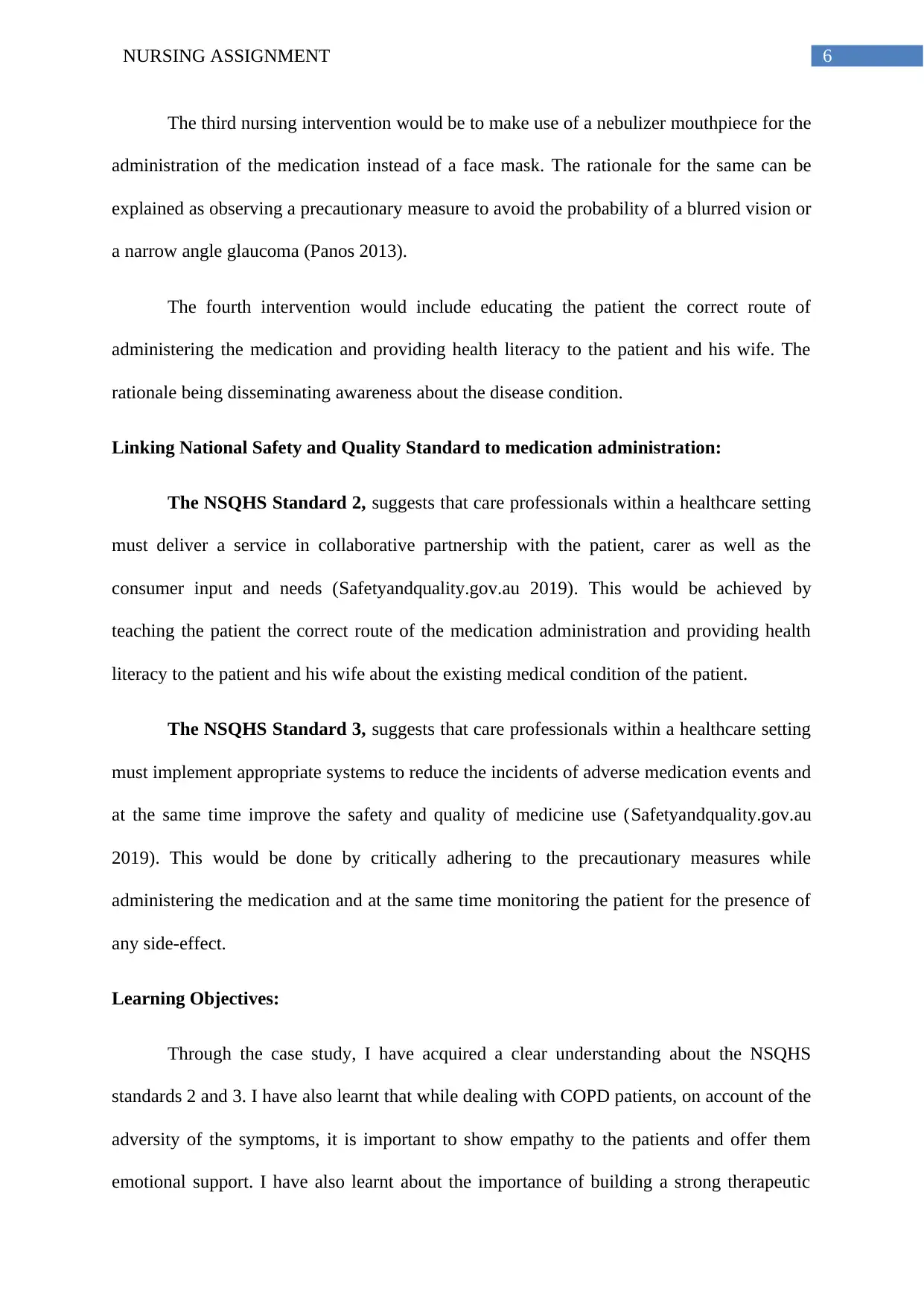
6NURSING ASSIGNMENT
The third nursing intervention would be to make use of a nebulizer mouthpiece for the
administration of the medication instead of a face mask. The rationale for the same can be
explained as observing a precautionary measure to avoid the probability of a blurred vision or
a narrow angle glaucoma (Panos 2013).
The fourth intervention would include educating the patient the correct route of
administering the medication and providing health literacy to the patient and his wife. The
rationale being disseminating awareness about the disease condition.
Linking National Safety and Quality Standard to medication administration:
The NSQHS Standard 2, suggests that care professionals within a healthcare setting
must deliver a service in collaborative partnership with the patient, carer as well as the
consumer input and needs (Safetyandquality.gov.au 2019). This would be achieved by
teaching the patient the correct route of the medication administration and providing health
literacy to the patient and his wife about the existing medical condition of the patient.
The NSQHS Standard 3, suggests that care professionals within a healthcare setting
must implement appropriate systems to reduce the incidents of adverse medication events and
at the same time improve the safety and quality of medicine use (Safetyandquality.gov.au
2019). This would be done by critically adhering to the precautionary measures while
administering the medication and at the same time monitoring the patient for the presence of
any side-effect.
Learning Objectives:
Through the case study, I have acquired a clear understanding about the NSQHS
standards 2 and 3. I have also learnt that while dealing with COPD patients, on account of the
adversity of the symptoms, it is important to show empathy to the patients and offer them
emotional support. I have also learnt about the importance of building a strong therapeutic
The third nursing intervention would be to make use of a nebulizer mouthpiece for the
administration of the medication instead of a face mask. The rationale for the same can be
explained as observing a precautionary measure to avoid the probability of a blurred vision or
a narrow angle glaucoma (Panos 2013).
The fourth intervention would include educating the patient the correct route of
administering the medication and providing health literacy to the patient and his wife. The
rationale being disseminating awareness about the disease condition.
Linking National Safety and Quality Standard to medication administration:
The NSQHS Standard 2, suggests that care professionals within a healthcare setting
must deliver a service in collaborative partnership with the patient, carer as well as the
consumer input and needs (Safetyandquality.gov.au 2019). This would be achieved by
teaching the patient the correct route of the medication administration and providing health
literacy to the patient and his wife about the existing medical condition of the patient.
The NSQHS Standard 3, suggests that care professionals within a healthcare setting
must implement appropriate systems to reduce the incidents of adverse medication events and
at the same time improve the safety and quality of medicine use (Safetyandquality.gov.au
2019). This would be done by critically adhering to the precautionary measures while
administering the medication and at the same time monitoring the patient for the presence of
any side-effect.
Learning Objectives:
Through the case study, I have acquired a clear understanding about the NSQHS
standards 2 and 3. I have also learnt that while dealing with COPD patients, on account of the
adversity of the symptoms, it is important to show empathy to the patients and offer them
emotional support. I have also learnt about the importance of building a strong therapeutic
Paraphrase This Document
Need a fresh take? Get an instant paraphrase of this document with our AI Paraphraser
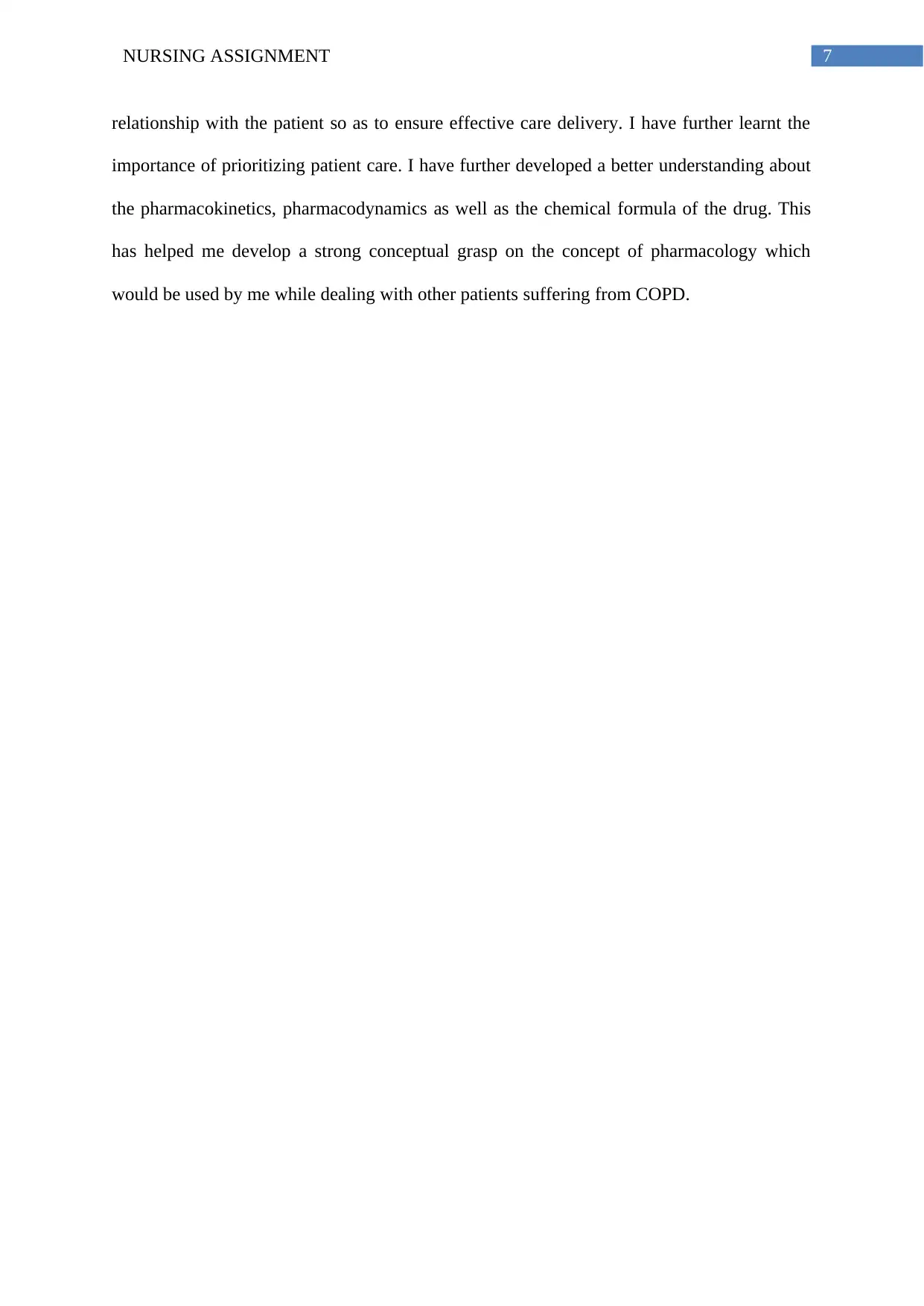
7NURSING ASSIGNMENT
relationship with the patient so as to ensure effective care delivery. I have further learnt the
importance of prioritizing patient care. I have further developed a better understanding about
the pharmacokinetics, pharmacodynamics as well as the chemical formula of the drug. This
has helped me develop a strong conceptual grasp on the concept of pharmacology which
would be used by me while dealing with other patients suffering from COPD.
relationship with the patient so as to ensure effective care delivery. I have further learnt the
importance of prioritizing patient care. I have further developed a better understanding about
the pharmacokinetics, pharmacodynamics as well as the chemical formula of the drug. This
has helped me develop a strong conceptual grasp on the concept of pharmacology which
would be used by me while dealing with other patients suffering from COPD.

8NURSING ASSIGNMENT
References:
Cheyne, L., Irvin‐Sellers, M.J. and White, J., 2013. Tiotropium versus ipratropium bromide
for chronic obstructive pulmonary disease. Cochrane Database of Systematic Reviews, (9).
Ejiofor, S. and Turner, A.M., 2013. Pharmacotherapies for COPD. Clinical Medicine
Insights: Circulatory, Respiratory and Pulmonary Medicine, 7, pp.CCRPM-S7211.
Ferguson, G.T., Ghafouri, M., Dai, L. and Dunn, L.J., 2013. COPD patient satisfaction with
ipratropium bromide/albuterol delivered via Respimat: a randomized, controlled
study. International journal of chronic obstructive pulmonary disease, 8, p.139.
Medicines.org.uk (2019). Ipratropium Bromide 250 micrograms/1ml Nebuliser Solution -
Summary of Product Characteristics (SmPC) - (eMC). [online] Medicines.org.uk. Available
at: https://www.medicines.org.uk/emc/product/3213/smpc [Accessed 23 Mar. 2019].
Montuschi, P.A.O.L.O., Macagno, F., Valente, S. and Fuso, L., 2013. Inhaled muscarinic
acetylcholine receptor antagonists for treatment of COPD. Current medicinal
chemistry, 20(12), pp.1464-1476.
Nakawah, M.O., Hawkins, C. and Barbandi, F., 2013. Asthma, chronic obstructive
pulmonary disease (COPD), and the overlap syndrome. The Journal of the American Board
of Family Medicine, 26(4), pp.470-477.
Panos, R.J., 2013. Efficacy and safety of eco-friendly inhalers: focus on combination
ipratropium bromide and albuterol in chronic obstructive pulmonary disease. International
journal of chronic obstructive pulmonary disease, 8, p.221.
Safetyandquality.gov.au (2019). [online] Safetyandquality.gov.au. Available at:
https://www.safetyandquality.gov.au/wp-content/uploads/2011/09/NSQHS-Standards-Sept-
2012.pdf [Accessed 23 Mar. 2019].
References:
Cheyne, L., Irvin‐Sellers, M.J. and White, J., 2013. Tiotropium versus ipratropium bromide
for chronic obstructive pulmonary disease. Cochrane Database of Systematic Reviews, (9).
Ejiofor, S. and Turner, A.M., 2013. Pharmacotherapies for COPD. Clinical Medicine
Insights: Circulatory, Respiratory and Pulmonary Medicine, 7, pp.CCRPM-S7211.
Ferguson, G.T., Ghafouri, M., Dai, L. and Dunn, L.J., 2013. COPD patient satisfaction with
ipratropium bromide/albuterol delivered via Respimat: a randomized, controlled
study. International journal of chronic obstructive pulmonary disease, 8, p.139.
Medicines.org.uk (2019). Ipratropium Bromide 250 micrograms/1ml Nebuliser Solution -
Summary of Product Characteristics (SmPC) - (eMC). [online] Medicines.org.uk. Available
at: https://www.medicines.org.uk/emc/product/3213/smpc [Accessed 23 Mar. 2019].
Montuschi, P.A.O.L.O., Macagno, F., Valente, S. and Fuso, L., 2013. Inhaled muscarinic
acetylcholine receptor antagonists for treatment of COPD. Current medicinal
chemistry, 20(12), pp.1464-1476.
Nakawah, M.O., Hawkins, C. and Barbandi, F., 2013. Asthma, chronic obstructive
pulmonary disease (COPD), and the overlap syndrome. The Journal of the American Board
of Family Medicine, 26(4), pp.470-477.
Panos, R.J., 2013. Efficacy and safety of eco-friendly inhalers: focus on combination
ipratropium bromide and albuterol in chronic obstructive pulmonary disease. International
journal of chronic obstructive pulmonary disease, 8, p.221.
Safetyandquality.gov.au (2019). [online] Safetyandquality.gov.au. Available at:
https://www.safetyandquality.gov.au/wp-content/uploads/2011/09/NSQHS-Standards-Sept-
2012.pdf [Accessed 23 Mar. 2019].
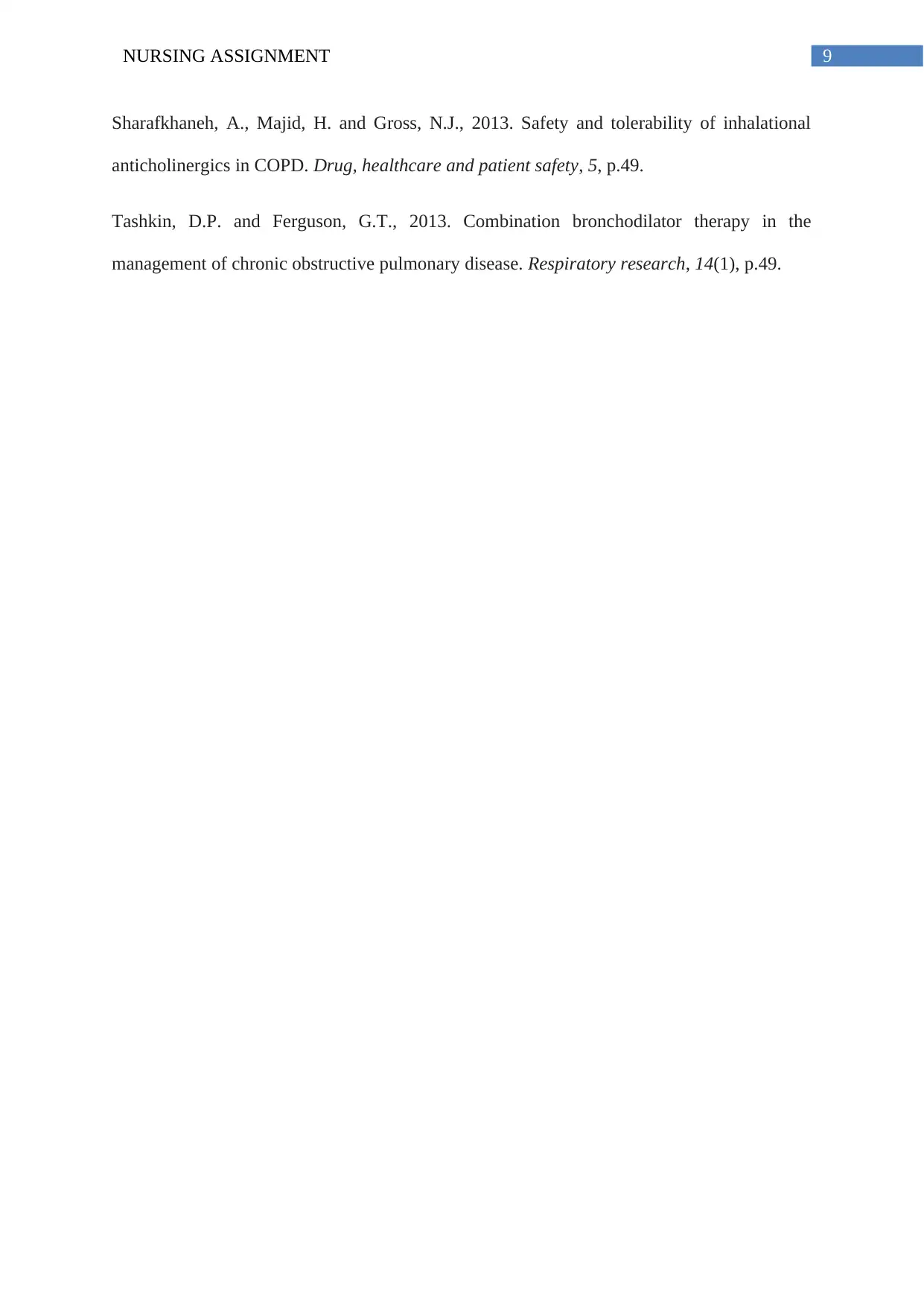
9NURSING ASSIGNMENT
Sharafkhaneh, A., Majid, H. and Gross, N.J., 2013. Safety and tolerability of inhalational
anticholinergics in COPD. Drug, healthcare and patient safety, 5, p.49.
Tashkin, D.P. and Ferguson, G.T., 2013. Combination bronchodilator therapy in the
management of chronic obstructive pulmonary disease. Respiratory research, 14(1), p.49.
Sharafkhaneh, A., Majid, H. and Gross, N.J., 2013. Safety and tolerability of inhalational
anticholinergics in COPD. Drug, healthcare and patient safety, 5, p.49.
Tashkin, D.P. and Ferguson, G.T., 2013. Combination bronchodilator therapy in the
management of chronic obstructive pulmonary disease. Respiratory research, 14(1), p.49.
1 out of 10
Related Documents
Your All-in-One AI-Powered Toolkit for Academic Success.
+13062052269
info@desklib.com
Available 24*7 on WhatsApp / Email
![[object Object]](/_next/static/media/star-bottom.7253800d.svg)
Unlock your academic potential
© 2024 | Zucol Services PVT LTD | All rights reserved.





